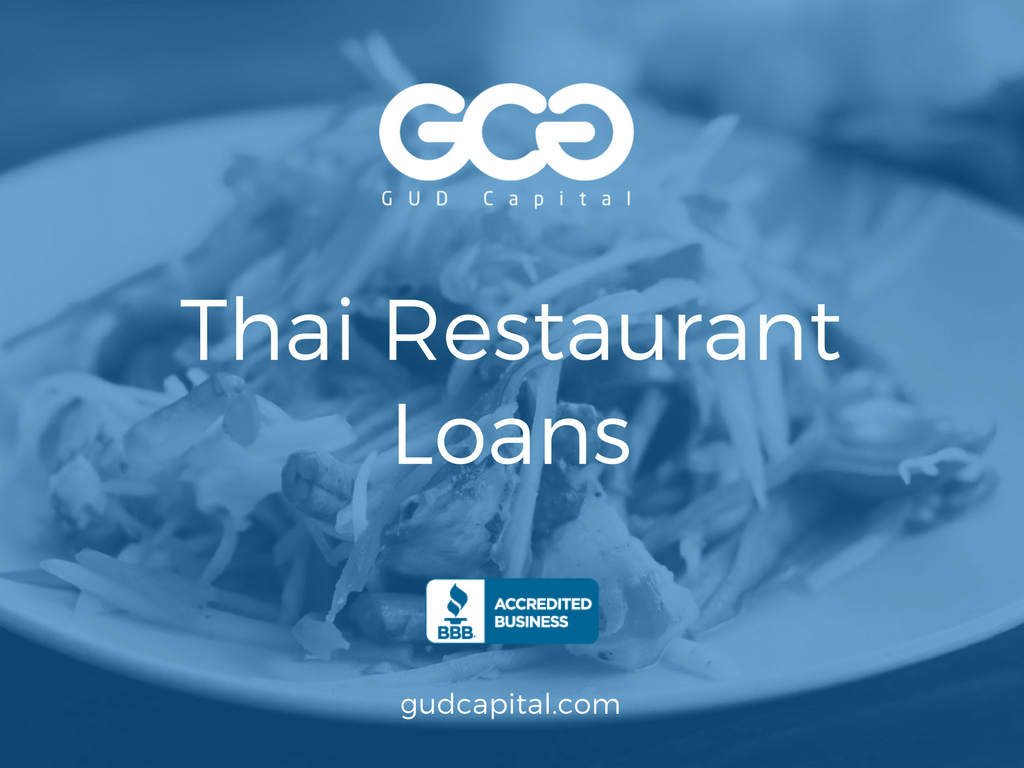Funding Options for Franchises
Thai cuisine is defined by its lightly prepared dishes with aromatic components and a spicy edge. It is a cuisine that is characterized by its intricacy, attention to detail, taste, color, and the use of ingredients with medicinal benefits, along with excellent flavor. Furthermore, Thai cuisine is divided by the five central regions of the country: Bangkok, Central Thai, Isan, Northern Thai, and Southern Thai and can thus take on unique variations of its traditional style and taste. However, a typical Thai dish anywhere includes four main seasonings: salty, sweet, sour, and spicy and most Thai dishes are not considered satisfying unless they combine all four tastes. Hence, the traditional aspects of Thai food mixed with current trends are what has made it a lasting and sought after cuisine around the world and what still contributes to the success of Thai restaurants today.
Quick-jump to the following sections:
- Thai Restaurant Bank Loans
- Thai Restaurant Line of Credit
- Unsecured Thai Restaurant Financing
- Thai Restaurant SBA Loans
- Alternative Thai Restaurant Loans
- Thai Restaurant Equipment Financing
- Thai Restaurant Cash Advance
- Thai Restaurant ACH Advance
Thai restaurants have brought the world dishes like Pad Thai, different noodle soups, and spring rolls, but they have also helped make white rice the new choice of carb—replacing bread. Thailand is one of the world’s top rice producers, so it is no surprise it is a huge part of their cuisine helping to make rice meals no longer foreign, but now a standard part of meals. One of the most popular rice varieties is Thai rice berry, which is a deep purple whole grain rice with softness and a delicious aftertaste. However, their most esteemed rice is Jasmine rice, sweet-smelling and long-grain that is indigenous to Thailand and it happens to be the most expensive. It is served steamed and is the finest rice to accompany most dishes, including Thai curries. So usually, the right meal in Thai restaurants should be composed of curry dishes, soups, some dips with fish and vegetables, along with some spicy types of salads. This entire meal set is accepted to be balanced regarding all of its flavors once you start eating; thus it should be the ideal menu for an owner to learn. By capitalizing on traditional Thai foods and flavors, owners of these restaurants can create an authentic menu to capture the Thai culture.
However, as with any business competition is inevitable and therefore you must be aware of what other restaurants are doing to prosper. Identifying the different methods that other businesses use to get customers, can then be recycled to your advantage by deriving ideas from them. As mentioned before about authentic Thai food, business owners need to be aware of the different ingredients being used as well as what is available in the US compared to Thailand—that calls for adopting and abiding by the American style and taste to continue thriving. For example, Americans love large portions of food which is not typical of Thai meals. It is not that they eat less, it is just that their shares are smaller with customers usually ordering multiple plates of an item. Additionally, spring rolls have become a significant trend in American Thai restaurants, and business owners are figuring this out and have been offering it with their lunch specials and as separate items. You can also find lots more meat in the dishes compared to traditional Thai food that is mixed with less. As a result, American Thai food has opted for more meat over herbs with their meals. Lastly, the Thai flavor level is vital to be as authentic as possible. Some American-Thai dishes tend to lack the proportionate amount of flavor—not hot, sour, rich or herbaceous enough; which are all the pillar taste combined to capture the culture.
Nevertheless, with flavor and culture aside, current and future owners should also take into consideration the location of their business. Owners should be aware of areas with a culturally diverse population such as large metropolitan areas in which ethnic restaurants would typically thrive. Another trend that is happening is the edition of vegan Thai cuisine that is creating an edge for Thai business owners as they now can reach vegans and vegetarians. Before it was frustrating for plant-based eaters since most Asian food contains a tiny amount of seafood that is incorporated into the seasonings that go into savory dishes. Now customers can find all vegan Thai restaurants, and it is making the cuisine even more popular. All in all, there are many reasons to start a Thai business now with its unforgettable flavors and rapidly growing demand.

Types of Thai Restaurant Loans
There are plenty of small business financing options for businesses in need of capital. The same is true of thai restaurants looking to cover expenses and expand their business. Some of the most common uses of a thai restaurant loan are to purchase a restaurant, refinance restaurant debt, general working capital and upgrades and repairs. Below we’ll take a look at the most common types of thai restaurant loans available to small business owners.
Bank Loans
For most thai restaurants seeking affordable financing with the best terms and lowest fees, a bank term loan will be the best option available. Bank loans are used for a variety of uses among thai restaurants, including purchasing a thai restaurant, opening a new thai restaurant, purchasing or upgrading restaurant equipment, as well as other general operating capital needs.
| Rates | 5-15% |
|---|---|
| Terms | 1-30 years |
| Funding Amounts | $50,000-$5,000,000 |
| Collateral | Required |
| Fees | Medium costs |
Bank Line of Credit
This type of preapproved financing that allows a restaurant owner to draw from whenever they need it, isn’t necessarily easy for a thai restaurant to obtain because most banks will use accounts receivable as collateral for a LOC. With that having been said, if you’re a thai restaurant owner with great credit and your restaurant has a history or profitability, you could get approved for a bank line of credit.
| Rates | 6-15% |
|---|---|
| Terms | 1-2 years |
| Funding Amounts | $50,000-$500,000 |
| Collateral | Not be Required |
| Fees | Medium costs |
Unsecured Line of Credit
Another type of affordable, preapproved financing that allows a thai restaurant owner to access capital whenever they need. The difference between an unsecured line of credit and a bank line of credit is that with an unsecured LOC, the approval will be solely-based on the business owner’s personal credit.
| Rates | 0% for 12 months |
|---|---|
| Terms | 1-2 years |
| Funding Amounts | $10,000-$500,000 |
| Collateral | Not be Required |
| Fees | Medium costs |
SBA Loans
SBA loans are another fantastic type of financing for thai restaurants seeking bank-rate loans, but have been unable to get approved from a conventional lender. SBA loans are used by thai restaurants for acquisitions, refinancing and consolidating restaurant debt, working capital and equipment purchases.
| Rates | 5-8% |
|---|---|
| Terms | 3-25 years |
| Funding Amounts | $50,000-$5,000,000 |
| Collateral | Required |
| Fees | Medium costs |
Alternative Loans
Alternative thai restaurant loans are a good form of financing for dining establishments (both dine-in and take-out) that are seeking quality rate financing, but without the credit and paperwork required by conventional lenders. Whereas a conventional loan may take many weeks or even months to complete, and alternative thai restaurant loan can be completed in as few as 3-5 business days.
| Rates | 7-25% |
|---|---|
| Terms | 1-5 years |
| Funding Amounts | $50,000-$500,000 |
| Collateral | May not be required |
| Fees | Medium costs |
Equipment Leasing
Rather than purchasing restaurant equipment outright — which may be very expensive for most owners of growing small businesses — a good option could be to, instead, lease the thai restaurant equipment. By leasing your restaurant equipment, you will only have to pay a fraction of the equipment’s cost as a downpayment, and then make monthly payment (at which point the restaurant owner will be provided the option to purchase the equipment outright.
| Rates | 8-25% |
|---|---|
| Terms | 1-10 years |
| Funding Amounts | $10,000-$5,000,000 |
| Collateral | Required |
| Fees | Medium costs |
MCA Cash Advance
Thai restaurants looking for fast financing for even the worst credit should consider selling a portion of their future credit card receivables in order to obtain a merchant cash advance. Since you are selling your credit card receivables, a merchant cash advance split isn’t a loan but instead a business to business transaction. The entire process can be completed in as little as a day with minimal paperwork.
| Rates | 1.10 – 1.50 |
|---|---|
| Terms | 3-18 months |
| Funding Amounts | $10,000-$500,000 |
| Collateral | Not required |
| Fees | Medium costs |
ACH Advance
A thai restaurant ACH cash advance is almost identical to a merchant cash advance, being they are both the sale of future revenue at a discount to a funder. The only difference is how a each is repaid: where a merchant cash advance is repaid by splitting daily credit card transactions, an ACH cash advance is repaid by having a set amount sent to the funder each day using Automated Clearing House.
| Factor rates | 1.10 – 1.50 |
|---|---|
| Terms | 3-24 months |
| Funding Amounts | $5,000-$2,000,000 |
| Collateral | Not required |
| Fees | Low to High costs |
Summary
There isn’t a shortage of financing options available to small businesses — especially restaurant owners. The key to getting the right business loan is to know your options, compare the loans, and choose the best structure to help your business grow. If you need help learning all the commercial financing options, and need help securing the best loan, reach-out to one of our funding specialists, and we’ll help you navigate the process.





















